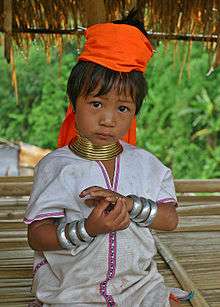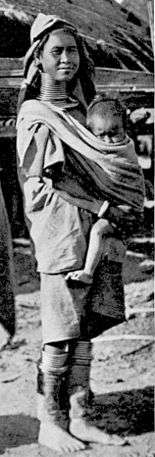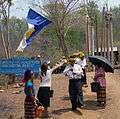Kayan people (Myanmar)
| ကယန်း | |
|---|---|
 A Kayan Lahwi woman | |
| Total population | |
| 130,000 | |
| Regions with significant populations | |
| Myanmar, Thailand | |
| 40,000 | |
| 20,000 | |
| 600 | |
| Languages | |
| Padaung language | |
| Religion | |
| Roman Catholicism | |

The Kayan are a sub-group of Red Karen (Karenni people), Tibeto-Burman ethnic minority of Myanmar (Burma). The Kayan consists of the following groups: Kayan Lahwi (also called Padaung, ပဒေါင် [bədàʊɴ]), Kayan Ka Khaung (Gekho), Kayan Lahta, Kayan Ka Ngan. Kayan Gebar, Kayan Kakhi and, sometimes, Bwe people (Kayaw).
Padaung (Yan Pa Doung) is a Shan term for the Kayan Lahwi (the group in which women wear the brass neck coils). The Kayan residents in Mae Hong Son Province in Northern Thailand refer to themselves as Kayan and object to being called Padaung. In The Hardy Padaungs (1967) Khin Maung Nyunt, one of the first authors to use the term "Kayan", says that the Padaung prefer to be called Kayan.[1] On the other hand, Pascal Khoo Thwe calls his people Padaung in his 2002 memoir, From the Land of Green Ghosts: A Burmese Odyssey. [2]
In the late 1980s and early 1990s due to conflict with the military regime in Myanmar, many Kayan tribes fled to the Thai border area.[3] Among the refugee camps set up there was a Long Neck section, which became a tourist site, self-sufficient on tourist revenue and not needing financial assistance.[4]
According to U Aung Roe (1993:21ss) Kayan number about 40,000 in Shan State (around the Pekon Township area) and 20,000 in Kayah State (around Demawso and Loikaw). A 2004 estimate puts the population at approximately 130,000.[5] About 600 Kayan reside in the three villages open to tourists in Mae Hong Sorn, or in the Ban Mai Nai Soy refugeee camp.
Geography
Present settlement of the Kayans

According to Kayan tradition the Kayan settled in the Demawso area of Karenni State (Kayah State) in 739 AD.[6] Today, they are to be found in Karenni (Kayah) State around Demawso and Loikow, in the southern region of Shan State and in Mandalay’s Pyinmana and Karen’s Than Daung township.
There are three Kayan villages in Mae Hong Son province in Thailand. The largest is Huay Pu Keng, on the Pai river, close to the Thai Myanmar border. Huai Seau Tao is a commercial village opened in 1995. Many of the residents of Nai Soi Kayan Tayar moved into the Karenni refugee camp in September 2008, but a few families remain there.
Most of the Kayan people in Mae Hong Son were from nine villages in Karenni State. The majority are from Rwan Khu and Daw Kee village. The people of Huay Pu Keng are mainly from Lay Mile village.
Culture
Brass coils
Women of the Kayan tribes identify themselves by their forms of dress. Women of the Kayan Lahwi tribe are well known for wearing neck rings, brass coils that are placed around the neck, appearing to lengthen it. The women wearing these coils are known as "giraffe women" to tourists.
Girls first start to wear rings when they are around 5 years old.[7] Over the years, the coil is replaced by a longer one and more turns are added. The weight of the brass pushes the collar bone down and compresses the rib cage. The neck itself is not lengthened; the appearance of a stretched neck is created by the deformation of the clavicle.[8] Many ideas regarding why the coils are worn have been suggested, often formed by visiting anthropologists, who have hypothesized that the rings protected women from becoming slaves by making them less attractive to other tribes. It has also been theorised that the coils originate from the desire to look more attractive by exaggerating sexual dimorphism, as women have more slender necks than men. It has also been suggested that the coils give the women resemblance to a dragon, an important figure in Kayan folklore.[9] The coils might be meant to protect from tiger bites, perhaps literally, but probably symbolically.[10]
Kayan women, when asked, acknowledge these ideas, and often say that their purpose for wearing the rings is cultural identity (one associated with beauty).
The coil, once on, is seldom removed, as the coiling and uncoiling is a lengthy procedure. It is usually only removed to be replaced by a new or longer coil. The muscles covered by the coil become weakened. Many women have removed the rings for medical examinations. Most women prefer to wear the rings once their clavicle has been lowered, as the area of the neck and collarbone often becomes bruised and discolored. Additionally, the collar feels like an integral part of the body after ten or more years of continuous wear.
In 2006, some of the younger women in Mae Hong Son started to remove their rings, either to give them the opportunity to continue their education or in protest against the exploitation of their culture and the restrictions that came with it. In late 2008, most of the young women who entered the refugee camp removed their rings. One woman who had worn the rings for over 40 years removed them. After removing the rings, women report discomfort which fades after about three days. The discoloration is more persistent.
The government of Myanmar began discouraging neck rings as it struggled to appear more modern to the developed world. Consequently, many women in Myanmar began breaking the tradition, though a few older women and some of the younger girls in remote villages continued to wear rings. In Thailand, the practice has gained popularity in recent years, because it draws tourists who bring revenue to the tribe and to the local businessmen who run the villages and collect an entry fee of 500 to 600 baht per person. The Karenni National People's Liberation Front (KNPLF), an armed cease-fire group, have made attempts to invite the Kayan to return to Kayah State to set up their own tourist villages.
In January 2008, the UNHCR expressed reservations about tourists visiting the Kayan villages in Northern Thailand due to the provincial government’s refusal to allow registered Kayan refugees to take up offers of resettlement in developing countries.[11] It is believed this policy was linked to their economic importance to the area. This policy was relaxed in late 2008 and a small group of Kayan have left for New Zealand in August 2008.[12] Others entered the main Karenni refugee camp (which is not open to tourists) in September 2008 and they are now eligible for resettlement.
Traditional religion
 Kay Htoe Boe poles.
Kay Htoe Boe poles. The Pwai dance.
The Pwai dance. Following the pwai dance the women sprinkle the men with water using eugenia leaves.
Following the pwai dance the women sprinkle the men with water using eugenia leaves. Fowl bone prognostication.
Fowl bone prognostication.
The Kayans’ traditional religion is called Kan Khwan, and has been practiced since the people migrated from Mongolia during the Bronze Age.[13] It includes the belief that the Kayan people are the result of a union between a female dragon and a male human/angel hybrid.[14]
The major religious festival is the three-day Kay Htein Bo festival, which commemorates the belief that the creator god gave form to the world by planting a small post in the ground. During this festival, held in late March or early April, a Kay Htoe Boe pole is erected and participants dance around the pole.[13][15] This festival is held to venerate the eternal god and creator messengers, to give thanks for blessings during the year, to appeal for forgiveness, and pray for rain. It is also an opportunity for Kayan from different villages to come together to maintain the solidarity of the tribe.
The Kayan have a strong belief in augury and nothing is done without reference to some form of divination, including breaking thatch grass, but most importantly consulting the chicken bones.[16]
In present times, the annual Kay Htein Bo festival is always accompanied by a reading of the chicken bones to predict the year ahead. Fowl bone prognostication can be witnessed in the Kayan villages in Thailand’s Mae Hong Son province during the annual festival and during “Cleansing Ceremonies” which are held when a family has encountered ill fortune. Dreams are also used to make predictions.
 Cleansing Ceremony Rituals
Cleansing Ceremony Rituals


Current religious practices
Although many of the Kayan still participate in these traditional festivals, in the 19th Century Italian missionaries worked amongst them for many years and today the majority of Kayan and Kayaw people are Roman Catholics. Statistics published in 2005 lists 306 Kayan villages, out of which 209 are Roman Catholic, 19 Kan Khwan, 32 Baptist, and 44 Buddhist, of which 2 belong to the Byamaso civil society organization.[5]
 Catholic First Communion
Catholic First Communion


See also
- Ndebele people of South Africa - An African tribe with a similar practice.
- The Kayan of Borneo share the name but are not related and do not have the same customs.
- Pole worship
References
- ↑ Rastorfer, Jean-Marc (1994), On the Development of Kayah and Kayan National Identity, Bangcock: Southeast Asian Publishing House
- ↑ Pascal Khoo Thwe, From the Land of Green Ghosts: A Burmese Odyssey (2002), ISBN 0-00-711682-9 Google books
- ↑ Thai Burma Border Consortium / A brief history of the Thailand Burma border situation
- ↑ Burmese Border Consortium Relief programme: January to June 2003
- 1 2 Eden Phan, Khon (2004), The Narratives, Beliefs and Customs of the Kayan People, Mae Hong Son: Kayan Literacy and Culture Committee
- ↑ Eden Phan, Khon (2004), The Narratives, Beliefs and Customs of the Kayan People, Mae Hong Son: Kayan Literacy and Culture Committee
- ↑ Mirante, Edith T. (1994), Burmese Looking Glass: A Human Rights Adventure and a Jungle Revolution, New York: Atlantic Monthly Press
- ↑ Keshishian, J.M. (1979), Anatomy of a Burmese Beauty Secret (155.6 ed.), Washington: National Geographic, pp. 798–801
- ↑ Mirante, Edith T. (September 2006), The Dragon Mothers Polish their Metal Coils, Guernica Magazine, retrieved 2009-01-01
- ↑ Mirante, Edith T. (January 1990), "Hostages to Tourism", Cultural Survival Quarterly (14.1)
- ↑ BBC news / Burmese women in Thai 'human zoo'
- ↑ huaypukeng.com
- 1 2 "Religion". Huay Pu Keng. Retrieved 2013-08-04.
- ↑ Virtua Design. "The Dragon Mothers Polish their Metal Coils by Edith Mirante - Guernica / A Magazine of Art & Politics". Guernicamag.com. Retrieved 2013-08-04.
- ↑ "Les peuples oubliés". Blogg.org. 2007-08-26. Retrieved 2013-08-04.
- ↑ Manna, Padre Paolo (1902), The Ghekhu-Karen Tribe of Eastern Burma, S. Giuseppe Pontificial Printing
External links
| Wikimedia Commons has media related to Kayan (Burma). |
- Padaung, a subgroup of Karen, The Peoples of the World Foundation
- Huay Pu Keng: Long Neck Village Website about this Kayan village in Thailand contains information on Kayan history, religion, and culture
- Karenni Homeland Current news from Karenni State
- Burmese women in Thai "human zoo" BBC News article
- Flicker Group: Long-Necked Karén
- Hostage to Tourism Article by Edith T. Mirante. Need to create account to view article.
- French Language page with introduction, notes and bibliography of Kayah, Kayan, Karenni et Yang Daeng by Jean-Marc Rastorfer